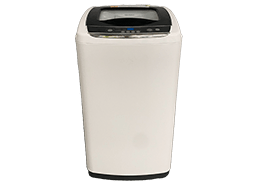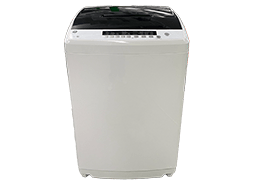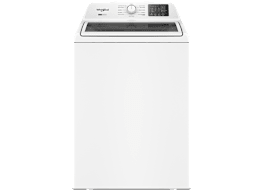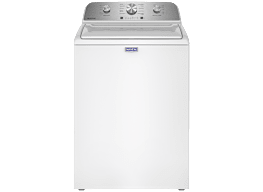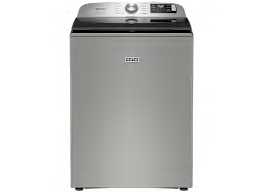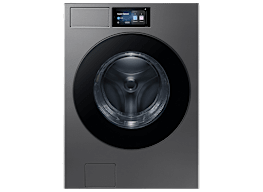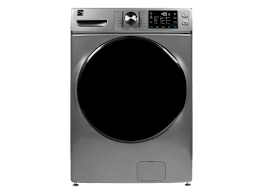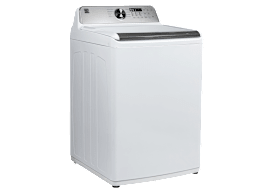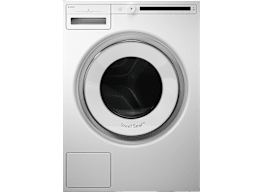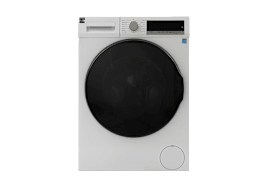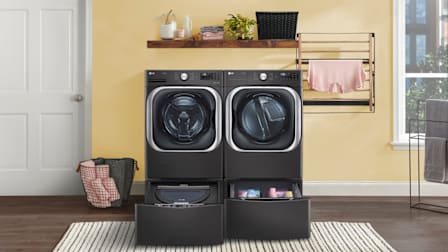Best Portable Washing Machines
We tested five portable washing machines to find the best mini washers for small apartments, dorm rooms, and RV living
When you shop through retailer links on our site, we may earn affiliate commissions. 100% of the fees we collect are used to support our nonprofit mission. Learn more.
If you live in a small apartment or dorm room, or are an avid recreational vehicle camper, you might not have room for a full-sized washing machine to do your laundry. Instead, you might consider using a portable washer. These smaller, compact washing machines require no special power outlets and can be hooked up to your sink and wheeled away to store after you’ve finished doing your laundry.


What we like: Light enough to easily be wheeled from room to room; has a lint filter inside the tub; user manual is helpful and clear.
What we don’t like: Can wash loads only in cold water; tub fills very slowly, so cycles are several minutes longer than expected.
The Black+Decker 0.9 cu. ft. Portable Washer earned the top spot in our testing for its performance washing a standard stain swatch and for its portability and ease of use. It ran quietly, notified us when a cycle ended, had easily customizable wash cycles, and was easy to move from one lab to another.
Of the three more traditional-looking portable washing machines we tested, it showed the best stain removal from a standard stain swatch with blood, carbon, cocoa, sebum, and wine. It was also the easiest to move, thanks to its lightweight design. An LED display on the control panel tells you how many minutes are left in a cycle. You can adjust the number of rinse cycles and the amount of time for both the wash and spin cycles in any preset wash cycle.
Inside the tub is a lint filter that caught loose threads from our 2-pound load before they were released into our drain hose, a useful feature to prevent clogging a sink drain at home.
The capacity of this portable washer is not very large. With just 2 pounds of laundry loaded into the washer, the tub was filled about ¾ of the way, precisely how full the user manual recommends filling the tub for best washing efficiency. A drain pump in the washing machine helps remove water from the tub after a cycle ends without having to elevate the machine or drain to a floor drain.
The user manual covers everything from setup to use and troubleshooting, is easy to understand, and has useful images throughout. According to the manual, high-efficiency detergent should be used to wash loads of laundry in this washer, though it does not specify if it should be powder, liquid, or single-dose-pack detergent. The manufacturer does say you should use only about ¼ to ½ of the maximum amount of laundry detergent recommended by the detergent manufacturer. It should also be used only with cold water, even when permanently installed to a water source. We could see both this model and the Super Deal portable washer, below, being useful in an RV setting and hope to test them in these capacities soon.

What we like: Left laundry just damp after the spin cycle; better load balancing in the spin tub than Super Deal model; very easy to move.
What we don’t like: Water inlet and drain hoses are very short; user manual has unclear instructions; spin tub can spin only about a third of the clothing washed in the wash tub at a time.
With a body made entirely from plastic and a less-than-ideal twin-tub design, the Auertech Portable Washing Machine proved to be a stain-zapping pro in our testing. It removed stains from a standard stain swatch well and left our test loads of laundry just a bit damp after the spin cycle ended. Traditional full-sized washing machines wash, rinse, and spin dry loads of laundry all in the same tub. With this twin tub-designed model, you have to move washed clothing into the spin tub to spin it dry, then move clothing back into the wash tub to rinse the remaining detergent from the garments before once again moving garments back into the spin dry for a final spin cycle. The amount of water and temperature of the water used for washing are also completely in your hands, controlled by the temperature of the water being supplied from your sink faucet.
With just two cycle options, normal and soft, and a tiny wash tub that was filled almost to capacity with just 2 pounds of laundry, you’ll be a lot more restricted with the loads of laundry you can wash with this portable washer. According to the brand, you should be able to wash up to 9 pounds of laundry at a time in the wash tub, but we did not find this to be the case in our testing. Almost identical in design to the model from Super Deal, this portable washer from Auertech had just one feature (other than the exterior color of the washer) that differentiated it from the Super Deal washer. When the spin cycle first began, the washer rattled for a few seconds before balancing the load of wet garments in the spin tub—something the Super Deal seriously struggled with.
The water inlet hose on the Auertech’s portable washer is short and does not secure tightly to a sink faucet. The power of gravity is what drains the water from the washer’s tubs, so you’ll have to elevate the machine to drain while keeping it close enough to a faucet to fill. In the user manual, the brand says you should use “washing powder” to wash laundry in this washer, but is unclear about the use of any other kinds of laundry detergent. It’s also riddled with grammar errors and confusing instructions for use.

What we like: Fits up to 8 pounds of laundry; eight wash cycles.
What we don’t like: Difficult to move because of its weight; doesn’t come with a second hose for installment to cold and hot water sources; drain hose is stiff and difficult to adjust over different heights.
The largest of the five portable washers we tested, the GE Space-Saving 2.8 cu. ft. Portable Washer can be used as a portable washer hooked up to a sink faucet or as a permanently installed washing machine. If you want to install it in a permanent position with both hot and cold water inlets, you’ll need to purchase water hoses from the brand because only one water inlet hose is included with the washer. We had trouble hooking up all the washers to the sinks in two of our labs, but we had the most trouble connecting this washer’s dual water inlet and drain faucet connection to the water supply we used for our evaluations. Through much trial and error, we were finally able to get the model installed without having the washer drain directly onto our lab floor.
With eight unique cycle options, detergent, bleach, and fabric softener dispensers, and adjustable settings for soil level and temperature (when connected to hot and cold water supplies), this washer is the most feature-packed of the models we tested. The tub fills automatically with the water necessary to wash a load of clothing and a short song signals when a cycle has ended. It did well in our stain swatch testing but was outperformed by the Black+Decker portable washer in four of the five stains included in testing. The 2-pound load we used for testing fit easily in this washer’s tub with room to spare for up to an additional 6 pounds of laundry. According to the user manual, you can use powder, liquid, and single-dose-pack detergents in this washer.
Clocking in at just under 100 pounds., moving this heavy GE portable washer was no easy task. Though it has two wheels, you have to tip the washing machine back onto the wheels to move it and we found that using a hand truck was easier than attempting to tilt the washer back on the small back wheels. As with many full–sized top-loading washing machines, reaching into the bottom of the tub of this washer requires a bit of stretching or the use of a stool for shorter users. To accommodate the installation of a dryer over the washer, the door has a hinge in the center that folds the door in half when opened.
Several colleagues in our labs noted how much this portable washing machine looked like a traditional, though slightly more compact, full-sized washing machine. This isn’t one you’ll be able to bring along on a camping trip or fit into a small college campus dorm room.
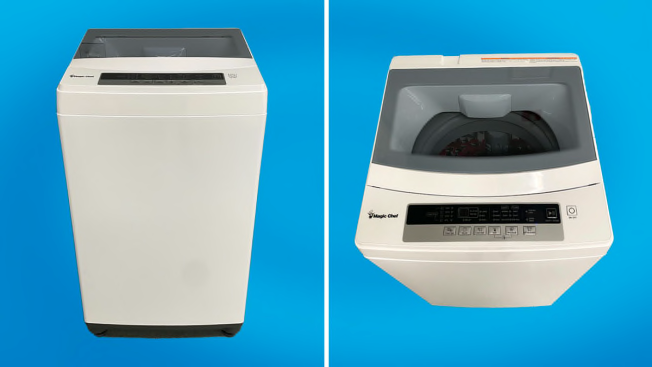
What we like: Has a detergent dispenser tray; hot and cold water supply hoses included with washer; delay start function up to 24 hours.
What we don’t like: Placement of handles was not very helpful for moving the unit.
The 1.7 cu. ft. Portable Compact Top Load Washer from Magic Chef has a lot of the same features as the Black+Decker model we tested. It has a lint filter inside the tub, notifies you when a cycle ends, runs very quietly, and is surprisingly easy to move. It removed stains from our standard swatches well, but not as well as the other washers we tested. The detergent dispenser tray can accommodate liquid and powder detergents, and the machine has a function to delay the start of a cycle up to 24 hours. An additional 2 pounds of laundry we added to the standard 2-pound load we used for testing fit comfortably inside this washer, with enough room for the garments to move around the tub during a cycle. Before a new wash cycle begins, the tub fills very slowly, adding extra time to a cycle that isn’t reflected in the minutes shown on the control panel’s LED screen. Cycles can be adjusted with an extra rinse, but you cannot manually add more time to cycles like you can with the Black+Decker portable washer.
Four inches might not seem like a big difference in width and depth, but when compared with the size of the GE portable washer we tested, this model was a much more reasonable choice for a small space. Though almost 30 pounds heavier than the Black+Decker portable washing machine, it was surprisingly easy to move this washer. Setup of the water inlet and drain hoses was simple, though in our lab it required some extra hose length to reach the water supply comfortably. The washer comes with both hoses necessary to install it to a cold and hot water supply.
The user manual provides helpful information about the installation of the machine, proper usage, and cycle descriptions.
Another Model We Tested
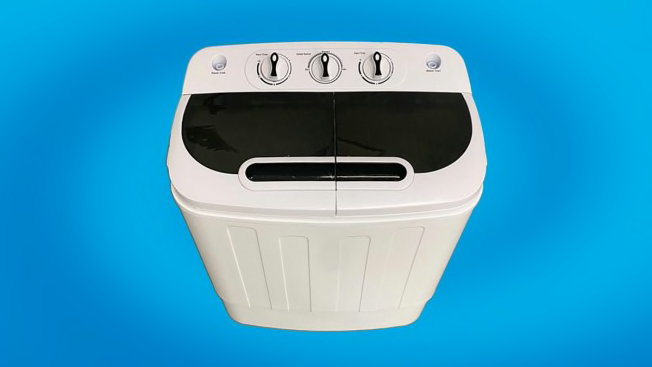
Similar in design and function to the Auertech portable washer, the Super Deal Compact Mini Twin Tub Washing Machine is made entirely of plastic, features a separate wash and spin tub, and has just two wash cycle options: normal and soft.
In the wash tub, washcloths seemed to clump up into a big ball in the center of the tub during the cycle, and when the cycle ended there was no notification, so we had to pay close attention to know when a load was ready to be moved into the spin tub. The spin tub is significantly smaller than the wash tub.
We had to spin dry a 2-pound load of laundry in four batches. When we tried to spin more than just a few items at a time in the spin tub, the whole washer rocked noisily back and forth. That said, garments came out just a bit damp after a spin cycle of just 5 minutes, the washer removed stains on our standard stain swatch well, and the unit was very easy to lift and move from one location to another.
Setting up the washing machine was tricky, and the user manual provided vague, hard-to-understand instructions that didn’t help much. There’s no drain pump, and the drain hose is very short, so the washing machine either needs to be placed on top of the counter next to a sink or drained onto the floor. The manufacturer does not recommend using this washer in damp areas like bathrooms, so using it in the shower is not an option. The connection of the water inlet hose to a sink faucet is not secured by any hose clamps or traditional hose fittings, and there’s no indication in the user manual of the kind or amount of detergent to use in this model, either.
Like the Auertech model, we can reasonably recommend this model only to users looking to wash very small loads of laundry and who are willing to wash clothing more manually.
Factors to Consider When Shopping for a Portable Washing Machine
Capacity: Washers with very small capacities—under 2 cubic feet—can accommodate only small loads of clothing at a time and might not be large enough to wash bedding or heavy towels. If you’re looking for a washer just for your undergarments, to take along on a camping trip, or for your baby’s clothes, this might not be an issue. Usually, the smaller a washing machine’s capacity, the less amount of floor space it will need in your home.
Size: If you’re keeping a portable washing machine in just one spot of your home, measure the floor space to make sure it will fit. If you plan to have the washing machine out only while it is in use, check to make sure the unit is not too heavy or that it has wheels on the bottom so you can easily move it to and from its storage space. Just as important as floor space is the space above the washer because you’ll need to make sure you can open the door to add and remove clothing from the tub.
Hose installation requirements: Portable washing machines need to be placed within a few feet of a sink to fill and drain. Most of the washers we tested had short hoses that could connect to a standard sink faucet. If your sink has a hose or a different design from these standard faucets, connection to a portable washer will require some finessing or extra parts. Look for extra faucet adaptors in your portable washer’s included materials before purchasing any other parts.
How We Evaluated Portable Washing Machines
To test the five portable washing machines we considered for this story, we temporarily installed each washer in one of our CR labs. We washed a 2-pound load of laundry in each model with a standard stain swatch and analyzed these swatches using the same instrument used in full-sized washing machine testing. We moved models down long hallways to find out how easy they were to move, ran different cycles if a model had more than one, reviewed each user manual for clarity and usefulness, and made note of how easy each model was to set up and use.
Tips for Using a Portable Washer at Home
Here are a few lessons we learned from testing portable washing machines in our labs.
- Before washing a load of laundry in a portable washing machine, run the washer without any garments inside and check for leaks at all water connections, both along the water inlet and drain hoses.
- Prior to moving the washer to a storage area, tilt the washer toward the drain hose and make sure that all hoses are free of water to avoid making a mess on your floors along the way.
- None of the models we tested had doors that locked during any parts of the wash cycle. If you want to add items into a load after a cycle has started, pause the cycle (if possible) and open the door slowly to allow the washer to stop spinning before adding any items into the tub.
- In our tests, we found that the models with drain pumps would not hold any water in the tub unless the drain hose was elevated. If you purchase one with a drain pump, make sure to elevate the drain hose according to the user manual’s instructions.
How Much Clothes Can Fit in a Portable Washer?
The amount of clothes that fit into the drum of a portable washing machine depends on the capacity of the washer. The smallest washers we tested can hold only up to 2 pounds of garments at a time, while the largest from GE with a capacity of 2.8 cubic feet can hold as much as an 8-pound load.
With any size washer, you should fill the tub only up to ¾ of the way with garments. Washers need the extra space to allow the clothes to move freely in the tub as the cycle progresses.
Is It Cheaper to Use a Portable Washing Machine?
Because portable washing machines are smaller than full-sized washers, they require less water and laundry detergent per cycle. However, you’re likely to end up using the same amount of water and detergent overall because you’ll need to do multiple loads of laundry to get through the same large loads you could do in just one cycle in a full-sized machine.
If you frequent a laundromat to do your laundry, a portable washer is a one-time cost (minus the purchase of detergent, water, and electricity bills at home), which may be cheaper than the recurring costs at a laundromat.

















